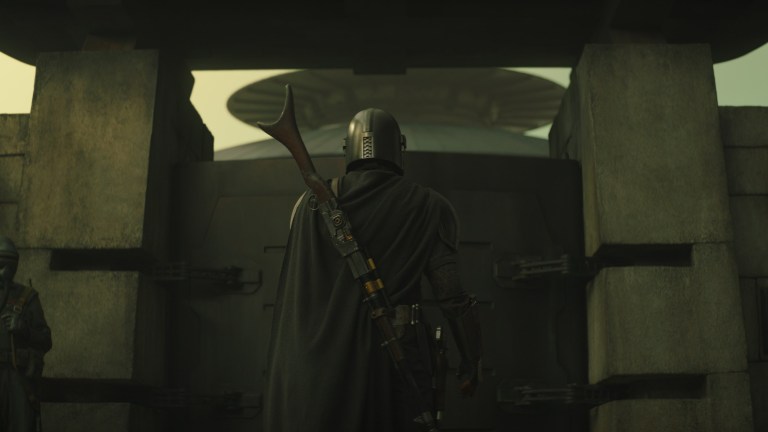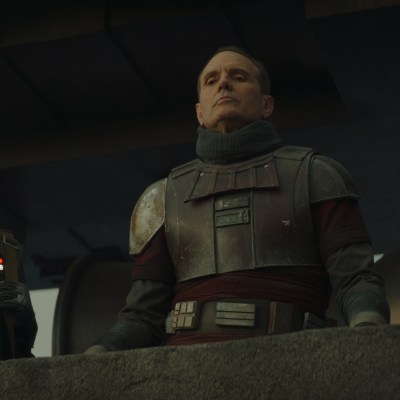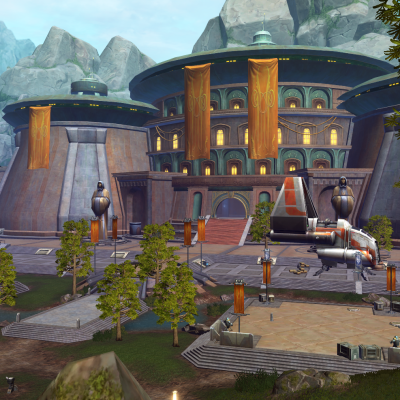Star Wars: The Mandalorian Season 2 Episode 5 Review – The Jedi
The Mandalorian Chapter 13, "The Jedi," brings back a fan-favorite hero while answering many of our questions about Baby Yoda.

This STAR WARS: THE MANDALORIAN review contains spoilers.
The Mandalorian Season 2 Episode 5
Gorgeous cinematography, lots of action, and plenty of actual answers to the show’s biggest mysteries — The Mandalorian Chapter 12, “The Jedi,” has everything. Drawing on his love for Japanese cinema and his deep understanding of the Star Wars canon he helped create, writer and director Dave Filoni has truly become a master.
The Mandalorian and Baby Yoda arrive at the city of Calodan on the planet Corvus, as Bo-Katan instructed in “The Heiress.” It’s a downtrodden place. Frightened citizens hide away from the punishment they might draw down for speaking to an outsider. The Imperial magistrate they fear, a tyrant named Morgan Elsbeth (Diana Lee Inosanto), has a job for Mando: kill the Jedi who keeps killing her soldiers, a task Lang, the hired enforcer played by Michael Biehn (Aliens), has been unable to accomplish.
The story beats happen rather quickly: Din Djarin finds Ahsoka Tano (Rosario Dawson) in the woods, learns that Baby Yoda was a Jedi Padawan named Grogu before he disappeared during the Imperial purge of the Jedi Temple, and helps the former Jedi defeat the magistrate. Throughout, the episode does slow down for lingering shots reminiscent of Westerns and samurai showdowns. While the previous episode directed by Filoni felt muddled when compared to the ones helmed by the more experienced live action directors around him, “The Jedi” proves he’s spent a lot of time figuring out how to translate animation to live action and produce a TV show that has the life and color of the former in the fidelity of the latter.
A lot of the fun in this episode comes from seeing a Jedi Master from the animated world pulled into live action and the effortless dynamic between Ahsoka, Din, and Baby Yoda/Grogu. Ahsoka is no longer a child tagging along with Anakin Skywalker, and as a hero in her own right, she can carry the entire legacy of the Jedi on her shoulders. Her demeanor has changed significantly since The Clone Wars, and this Rebels-and-beyond version is my favorite manifestation of the character yet. This era and her decades of experience allow her to stand on her own. She also still clearly cares deeply for the people around her and those she left behind when she left the Jedi Order.
Dawson is forceful and deliberate in fight scenes, but with an air of gentle self-assurance just like Obi-Wan Kenobi or Luke Skywalker. Moments of levity and mid-battle smiles evoke the teenager from The Clone Wars without being cloying or too self-referential. Like Filoni, Ahsoka doesn’t need to prove she belongs anymore. She simply does.
As much as I complained about cameos while reviewing Rebels, The Mandalorian‘s references to the animated canon continue to delight in “The Jedi.” But they’re also a bit bizarre: name-dropping Grand Admiral Thrawn takes a lot of the air out of a pivotal scene between Ahsoka and Elsbeth. That said, it’s also a fun puzzle piece with which to tease fans of Rebels. Thrawn is still missing, which means Jedi apprentice Ezra Bridger is still missing, too. Ahsoka set out to look for Ezra at the end of that animated series, and it seems that she’s still searching all these years later.
Ahsoka’s story connects to another part of the saga as well. Her reluctance to train Grogu shows she’s afraid of training another Jedi who might fall to the dark side like Anakin did. I can’t emphasize enough how well she fits into this particular episode both emotionally and physically, her zebra-like striped coloration adding to the alien look of the planet. She’s just a lot of fun to watch.
It’s important to note in this review that Dawson’s casting as Ahsoka is a controversial one. Last year, a former employee of Rosario Dawson and her family sued the actor, accusing the family of transphobia and physical assault. But 18 of the 20 accusations, including discrimination and misgendering, have since been dropped, and Dawson has called the allegations “baseless.” The claims of a physical altercation with Dawson’s mother will be considered in court in December. Some Star Wars fans are collecting funds for the Transgender Law Center in response.
Dawson isn’t the show’s only controversial casting at the moment. Her debut on The Mandalorian also comes just a week after some fans petitioned for Disney to fire Gina Carano (Cara Dune) from the show after she posted anti-mask rhetoric on Twitter, all while Covid-19 cases are consistently hitting record highs in the US.
Aside from Ahsoka’s presence, the episode demonstrates a mature sensibility by understating the nature vs. industrialization theme often present in Star Wars. The Clone Wars isn’t exactly known for being subtle, but this episode gives off the sense of having been refined down and down until an elegant story sat on top of the easily understood but never quite spoken threat. The Imperial magistrate is obviously cruel to both the people and the environment. No one has to come out and say that she’s poisoning the ground to see that the forest around the village is dead and the magistrate walls off her own garden inside. The setting also quietly sends the message that the Jedi is on the side of nature as well as the people.
And what about the heart of the show, the Mandalorian and Baby Yoda? The episode doesn’t play the baby’s prospective separation from its father figure as heart-wrenching. Instead, it’s almost inevitable that the two will walk away together. There’s no way showrunner Jon Favreau, Filoni, or or the rest of the creative team will write either character out of the show. Because of this, Mando doesn’t seem particularly worried that he might lose the child. Any pathos I might have wanted here instead comes from Ahsoka’s obvious fear of training a difficult student only to have him end up like Anakin. Although she isn’t officially a Jedi anymore, she’s seen Anakin’s life first hand, and believes that the Jedi were right when they declared strong attachments are a path to the dark side.
If Grogu’s love for Mando becomes possessive or destructive, he could go down the route of Darth Vader. The dynamic between Ahsoka and Din, both of them comfortable together and never seeming to need to prove anything to the other, provides this uncertainty with a backdrop of reassurance. If anyone can make things okay for the child, it’s these two.
The Jedi training scenes are utterly delightful. The camera does a lot of work making Ahsoka seem mystical, particularly when she and the child are silhouetted against the moon like the Madonna and baby in a halo. One of the great joys of Star Wars is watching Jedi be cool and dangerous. The fog of Corvus works so well for that, with Ahsoka a wraith in the mist or the alleyways. And yet her appearance is not muddled or teased, not obscured behind inclement weather or night. The camera takes a comic book joy in watching her command a scene. And Pedro Pascal shines as usual, his head tips, cowboy walk, and deadpan responses (“I keep it around for luck”) are all equally expressive. His praise for the child is particularly heartwarming.
“The Jedi” is a reminder, as a lot of this season has been, that this show is both a visual spectacle and a technical masterclass in doing a lot with a little. It’s great to get out of the deserts of Tatooine and Nevarro. The Mandalorian continues to be so, so entertaining, and to connect to other parts of Star Wars without feeling precious about them.



